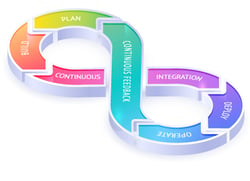 Manufacturing companies that want to enhance their competitiveness, flexibility, and responsiveness are adopting Agile methods, at least in a hybrid framework. This switch enables their software and hardware teams to collaborate more effectively while enhancing their overall product development process. Following Agile principles also brings companies closer to their customers by studying their needs, incorporating feedback into prioritization processes, and encouraging innovation at all stages of development.
Manufacturing companies that want to enhance their competitiveness, flexibility, and responsiveness are adopting Agile methods, at least in a hybrid framework. This switch enables their software and hardware teams to collaborate more effectively while enhancing their overall product development process. Following Agile principles also brings companies closer to their customers by studying their needs, incorporating feedback into prioritization processes, and encouraging innovation at all stages of development.
Implementing new systems and strategies in large organizations is never seamless, but it can be smoother when proven strategies are utilized. This article examines three recommended Agile strategies to help manufacturers adapt to Agile methods with less friction.
Strategy #1: Implementing Prioritization Techniques
 Prioritization techniques are essential strategies to ensure that product teams focus on delivering the most valuable features and improvements first, which is a vital tenant of Agile methodology. Organizations will prefer certain formulas over others, depending on how they measure value or the KPIs they track. Here are some common product scoring formulas that can help determine the next priority for a product.
Prioritization techniques are essential strategies to ensure that product teams focus on delivering the most valuable features and improvements first, which is a vital tenant of Agile methodology. Organizations will prefer certain formulas over others, depending on how they measure value or the KPIs they track. Here are some common product scoring formulas that can help determine the next priority for a product.
The MoSCoW Method helps teams decide which ideas should be prioritized. It stands for Must-Have, Should-Have, Could-Have, and Won't Have.
Value vs. Effort (or Cost) prioritizes tasks based on their perceived value to the customer or business against the effort or cost required to implement them.
The Kano Model focuses on satisfying basic needs, improving performance features, and adding delighters for competitive advantage (Basic, Performance, and Delighters).
WSJF (Weighted Shortest Job First) divides the cost of delay by the job size. This formula prioritizes tasks with the highest WSJF score, indicating the most significant business value relative to the effort involved.
The RICE Framework rates each feature based on Reach, Impact, Confidence, and Effort or (Reach x Impact x Confidence) / Effort. This formula prioritizes tasks with the highest RICE score.
Cost of Delay estimates the cost of delaying a feature's delivery. This formula prioritizes features with the highest cost of delay to avoid potential losses or missed opportunities.
Opportunity Scoring evaluates each feature based on its potential to seize market opportunities or solve critical problems. This formula prioritizes features with the highest opportunity score.
Software Tools for Prioritization
The choice of prioritization method often depends on the specific needs of the product, team, and organization. These scoring methods help Agile teams make informed decisions about what to build next, ensuring they deliver maximum value with available resources. Having a preferred scoring method is one step towards better product decisions. Having the right software tools to make idea scoring accessible and transparent is another. With innovative product development tools, such as our product roadmap management software, cross-collaborative teams can score and prioritize in the same central location.
Strategy #2: Rapid Prototyping and Creating Minimum Viable Products (MVPs)
 Switching from a stage-gate model to an Agile methodology takes time. There are many differences in process between the two methodologies. Where Stage-Gate requires a full prototype built and tested before approval for production, Agile focuses on constructing a minimum viable product (MVP) subject to continuous testing and verification throughout the development planning process.
Switching from a stage-gate model to an Agile methodology takes time. There are many differences in process between the two methodologies. Where Stage-Gate requires a full prototype built and tested before approval for production, Agile focuses on constructing a minimum viable product (MVP) subject to continuous testing and verification throughout the development planning process.
Validating Ideas with Rapid Prototyping
Rapid Prototyping involves quickly creating physical models or prototypes of a product using 3D printing, CNC machining, or other advanced manufacturing technologies. This process allows manufacturers to visualize and test product designs early in the development process, identifying flaws and making necessary iterations promptly.
The strategy of rapid prototyping facilitates communication and collaboration among cross-functional teams, suppliers, and stakeholders by providing tangible representations of product ideas. It also supports cost-effective small-batch production and customization, leading to faster market entry and enhanced customer satisfaction.
Testing Markets with MVPs
MVPs are simplified versions of a product with core features that allow manufacturers to test hypotheses, gather feedback, and validate market demand before investing heavily in full-scale production. The MVP uses minimal resources and time, reducing the risk of developing products that do not meet customer needs or market expectations. MVPs also support Agile methods by encouraging a feedback-driving mindset that often leads to the development of products that align closely with customer preferences and market trends.
Strategy #3: Encouraging Continuous Monitoring and Feedback Mechanisms
 Agile manufacturing is not a static process; it requires continuous monitoring of processes and feedback mechanisms to make adjustments where necessary. From optimizing the manufacturing floor to better aligning products to customer needs, continuous feedback mechanisms provide a strategy to ensure feedback comes in, and product teams are informed. This valuable information cycle promotes improvement and innovation while keeping the customer's voice in discussions. Here is an overview of what continuous monitoring and feedback mechanisms typically look like in the manufacturing industry:
Agile manufacturing is not a static process; it requires continuous monitoring of processes and feedback mechanisms to make adjustments where necessary. From optimizing the manufacturing floor to better aligning products to customer needs, continuous feedback mechanisms provide a strategy to ensure feedback comes in, and product teams are informed. This valuable information cycle promotes improvement and innovation while keeping the customer's voice in discussions. Here is an overview of what continuous monitoring and feedback mechanisms typically look like in the manufacturing industry:
Real-time Data Collection: Sensors, IoT devices, and other technologies are used to collect real-time data on various aspects of the manufacturing process such as temperature, pressure, speed, and quality metrics.
Automated Systems: Automated systems are employed to monitor equipment performance, detect anomalies, and predict maintenance needs to prevent downtime.
Quality Control: Continuous monitoring of product quality at different stages of production helps identify defects early on and ensures adherence to quality standards.
Supply Chain Monitoring: Tracking materials and components along the supply chain helps optimize inventory levels, reduce lead times, and improve overall efficiency.
Collecting and Discussing Feedback
 In addition to establishing continuous monitoring methods, organizations also require feedback mechanisms to collect and discuss valuable information that can improve systems and products. These feedback mechanisms may include the following:
In addition to establishing continuous monitoring methods, organizations also require feedback mechanisms to collect and discuss valuable information that can improve systems and products. These feedback mechanisms may include the following:
Performance Metrics: Key performance indicators (KPIs) are used to measure and evaluate different aspects of the manufacturing process, providing feedback on efficiency, productivity, and quality.
Quality Feedback Loops: Feedback loops are established to ensure that any quality issues identified during monitoring are promptly addressed and corrective actions are taken.
Employee Feedback: Encouraging employee feedback on the manufacturing process can help identify areas for improvement, enhance collaboration, and boost morale.
Customer Feedback: Gathering customer feedback on product quality, delivery times, and service levels can drive continuous improvement efforts in manufacturing.
Taking Action Based on Monitoring and Feedback
 Agile methods promote continuous improvement, which is why monitoring and feedback collection need to lead to smart decisions. Important opportunities may be lost if results are filed away and never looked at again. The most effective way to ensure that the data collected is analyzed, evaluated, and shared is to create closed-loop systems. These systems ensure real-time feedback is generated from monitoring data to make adjustments and improvements throughout the organization.
Agile methods promote continuous improvement, which is why monitoring and feedback collection need to lead to smart decisions. Important opportunities may be lost if results are filed away and never looked at again. The most effective way to ensure that the data collected is analyzed, evaluated, and shared is to create closed-loop systems. These systems ensure real-time feedback is generated from monitoring data to make adjustments and improvements throughout the organization.
Promoting a culture of continuous improvement also supports the mindset that data and feedback are drivers of innovation that streamline processes and enhance the overall performance of teams and products. By implementing robust continuous monitoring and feedback mechanisms in manufacturing, companies can achieve greater operational efficiency, higher product quality, and increased customer satisfaction.
Keeping Your Development Teams Agile
Keeping your teams Agile requires transparent communication tools, whether it's your engineering teams, software development teams, or other product stakeholders. Product roadmap management software keeps your roadmaps, timelines, and prioritization data in one central source of truth all teams can access in real time.
Book your free demo of Gocious product roadmap management software to see how the right tools can help keep your organization Agile.

